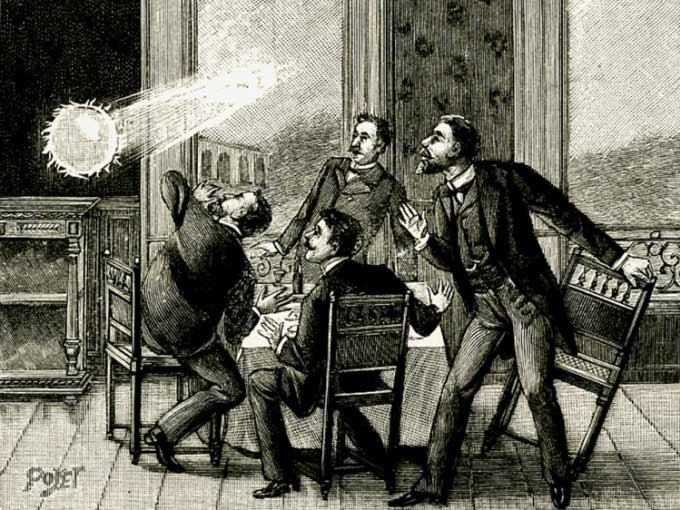A monk’s account of a mysterious phenomenon along the River Thames in 1195 may be the oldest description of ball lightning in England.
Researchers may have discovered the earliest record of the rare weather phenomenon known as ball lightning in England. Ball lightning, often associated with thunderstorms, is a phenomenon that lacks a clear explanation and is described as a luminous spherical object with an average diameter of 25 cm, sometimes reaching several meters.
Professor of Physics Brian Tanner and Professor of History Giles Gasper at Durham University linked ball lightning while studying a medieval text. The account by the monk Gervase at Christ Church Cathedral Priory in Canterbury predates the previous record of ball lightning in England by nearly 450 years. This new finding was published in the Weather journal of the Royal Meteorological Society.

A French illustration showing ball lightning crashing into a room through a window. (Photo: World History Archive/Alamy Stock)
In the Chronicles from around the 12th century, Gervase wrote that “a miraculous sign descended near London” on June 7, 1195. He described a thick, dark cloud emitting a white substance that developed into a spherical shape beneath the cloud, from which a fiery orb fell toward the river.
The research team at Durham University compared Gervase’s account in the Chronicles with reports of ball lightning from ancient and modern times.
“Ball lightning is a rare weather phenomenon that we still do not fully understand today. Gervase’s description of the white substance escaping from the dark cloud, falling as a rotating fiery sphere, and then moving slightly sideways closely resembles historical and contemporary descriptions of ball lightning,” Tanner stated.
“If Gervase is indeed describing ball lightning, which we believe he is, then this will be the earliest description of this phenomenon in England ever discovered,” Tanner added. Prior to this record, the oldest report of ball lightning in England was during a major thunderstorm in Widecombe, Devon, on October 21, 1638.
“The focus of Gervase’s writings is on the Christ Church Cathedral Priory, Canterbury, its disputes with neighbors, the Archbishop of Canterbury, the actions of the king, and the nobility. However, he was also interested in natural phenomena, from cosmic events and signs in the sky to floods, famines, and earthquakes,” Gasper noted.
The research team assessed the reliability of Gervase as an author and witness. They previously examined his records of solar eclipses and his description of the separation of images of the crescent moon.
“Gervase appears to be a reliable reporter, so we consider his description of the fiery sphere over the River Thames on June 7, 1195, to be the first convincing and comprehensive account of ball lightning anywhere,” Gasper remarked.
Legends of Ball Lightning
The sighting of mysterious luminous spheres has fascinated humanity across various cultures, inspiring countless fantastical explanations and mythical stories.
In the folklore of the Outback in Australia, they are known as Min Min lights—mysterious glowing orbs that follow people around at night.
The hitodama in Japan are said to be ghostly fireballs believed to be the manifestation of souls separated from their bodies after death.
In English folklore, they are referred to as will-o’-the-wisps, understood to be mischievous fairies trying to lead lost travelers astray.
This phenomenon has also been described worldwide. An engraving on the door of the Golden Temple in Amritsar, India, depicts a ball lightning explosion inside the temple, witnessed by hundreds of devotees.
Czar Nicholas II of Russia described an encounter in which a fiery ball lightning entered his room. Ball lightning was again observed and recorded by a storm observing team in Qinghai, China, in 2012.
Despite the frequency of sightings, photographic and video evidence of ball lightning is extremely rare. Laboratory efforts to replicate and explain ball lightning have not been entirely successful, although some have shown great promise.
The lack of concrete evidence for the existence of ball lightning has led some researchers to question the phenomenon beyond anecdotal accounts.




















































